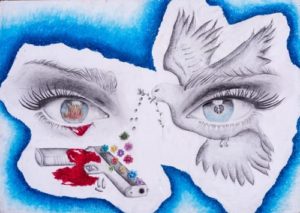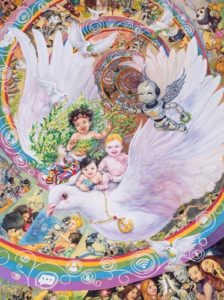What is a global citizen? How is one socialized to understand the expectations and reality of gaining a proper grasp on this ideal? Is this something implemented from childhood or developed and honored through age and experience? When beginning to answer this question I started sorting through the timeline of my life trying to understand when I first grasped the idea of a global citizen; or if I even still had to work on this. The first significant memory came from my middle school with something as simplistic as a schoolwide competition. My middle school participated in a contest run by The Lions Club; The “International Peace Poster Contest”. Due to the Lions Club official website, this contest “gives children everywhere the chance to express their visions of peace and inspire the world through art and creativity” (The Lions Club, 2019). This contest helps students understand the Functionalism Theory; that the whole world can be connected through something as easy as a drawing.
The above photos are examples of current winning submissions; all done by 13 year olds from around the world. This portrays the beginning of becoming a global citizen through the ability of analyzing and developing a comprehension of the world surrounding oneself with the idea of peace. The international desire of peace helps unite nations over one common goal; setting up an understanding of the interactions between countries. This contest forces young students to portray peace on an international scale, gaining a knowledge of what is happening globally. With this foundation, students are then encouraged to continue to connect the globe on a larger scale, creating a global citizen and humanitarian.
Starting a connect between nations in such a way at young ages may encourage the true existence of a global citizen who can “see ourselves as part of an emerging world community, and are committed to helping build this community’s values and practices” (Israel, 2012). While a contest for children may appear to be the ideal path towards one’s development into a global citizen, there is far more adversity that comes along with gaining this seemingly impossible title. Barriers such as ethnocentrism, racism, and crisis within own nations prevent people from viewing the world as one peaceful depiction. Specifically, Cole in “The White-Savior Industrial Complex” explains that “there are serious problems of governance, of infrastructure, of democracy, and of law and order. These problems are neither simple in themselves nor are they reducible to slogans. Such problems are both intricate and intensely local. How, for example, could a well-meaning American “help” a place like Uganda today?” (Cole, 2012). Cole goes onto explain that questions such as these that are posed only affirm the already existing barriers. In this particular situation, Americans are blinded by the fact that their policies are negatively affecting other countries. This goes against the above definition of a global citizen, practicing and helping to move towards one community. A community that cherishes all its members and prioritizing the people over materials.
Unfortunately, the creation of a global citizen is not as simple as creating a poster portraying peace throughout the world. While children are the ones partaking in The International Peace Poster contest, they must implement these original thoughts and utilize this foundation into the world as humanitarians.
References
Cole, Teju. “The White-Savior Industrial Complex.” The Atlantic, Atlantic Media Company, 11 Jan. 2013, www.theatlantic.com/international/archive/2012/03/the-white-savior-industrial-complex/254843/.
Bell, Ronald, et al. “What Does It Mean to Be a Global Citizen?” Kosmos Journal, 1 Apr. 2014, www.kosmosjournal.org/article/what-does-it-mean-to-be-a-global-citizen/.
“Kindness Matters.” Community Volunteer Work, Local Volunteer Work, Get Involved | How to Join Lions Club, www.lionsclubs.org/en/start-our-approach/youth/peace-poster/current-winners.




5 Comments
I thought the correlation between the children’s painting submission and being/defining a global citizen draws an interesting perspective. From your post, you mention how it’s so much more than a simple painting or expression of this International Peace Painting contest but rather is beyond the spectrum to which these children can grasp. However, despite this the fact that they are able to understand issues and be able to creatively express this than there is hope going forward for a change.
I think it is very interesting how you were able to connect these questions and concepts to this contest when you were younger. It is true that the idea of a global citizen is probably brought up to children at an early age, even if they aren’t aware of it. It is a nice idea that something like this art contest can unite people together. However, I do agree that the definition of a global citizen isn’t an easy one and humanitarian aid is not always looked at in a positive light. It is a very complex issue that will probably not be solved and completely understood any time soon.
This post made me think a lot about the recent State of the Union Address a few days ago. Trump mentioned the idea of an “America First” mentality. If all of America were to, for some reason, adopt this policy then you would see a large decrease of American aid work. Why should anyone have an empathetic response to a culture that we have been barred from learning about? Overall, I think you’re correct in stating that it is near impossible to define term, the global citizen. What a frustrating thing about this subject.
It seems like the definition of a global citizen will forever be critiqued as long as humanitarian aid efforts are, as both are relevant to each other. Because we do in part define a global citizen as one who devotes time to care and contribute to the wellbeing of communities aside from their own, which is what American humanitarians do. But then at the same time when we are contributing to the betterment of another society we have backlash from others or the receiving country that we are degrading their existing situation for the long run. I think the main flaw with humanitarian aid is that it is not continuous and usually just an intervention, but the other society needs a sort of mentor to facilitate a long term change.
I think that the second question that you rhetorically pose in the beginning of your post is incredibly interesting and insightful. You touch on the idea that as individuals within a larger society/body, we do not always have the power to control our own preconceived notions or thoughts concerning a topic, especially if they are culturally infused from an early age. This ties well into the symbolic interactionism theory as different people with different upbringings learn to see the world differently. For example, given the current events taking place within the context of the US, a Latinx child growing up today might grow up with a inherent fear of law enforcement and authority figures given the persistent ICE raids taking place in NC in the last few weeks. On the other side, a white child may not even hear about these raids nor know what ICE is. These express two very different world views and two very different lived experiences which were manufactured by our society and will ultimately affect the future opinions and actions of each individual. I really enjoyed how you added in the anecdote about the art project; I would definitely agree with you in that certain parts of the human experience, such as art, have a strong power to unite people across linguistic and cultural boundaries.